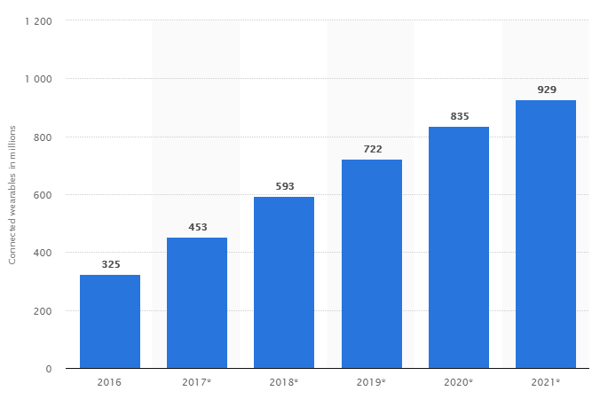Mobile apps are undergoing a significant makeover to meet the increasing demand for conversational commerce and on-demand services in the business world. To consumerize services with better user experiences developers are leveraging the Internet of Things (IoT). This is increasing demand for IoT, further scaling up the requirement for mobile apps, to serve as the communication enabler platform. This demand is increasing the complexity of mobile app development while improving functionality.
Mobile Apps and IoT Complement One Another
By 2020, it is estimated that smartphone usage is estimated to be 6 billion devices and IoT Market to be $520 Billion. More than 65 percent of companies around the globe are expected to have IoT platforms and respective software applications and services. In recent years, usage of smart wearables usage has increased significantly extending the capacity of IoT devices. Total revenue of the wearables segment in 2018 accounts to $12.8 million in 2018.
Figure: Statista global projections on wearables devices usage stats
| Device | 2017 | 2018 | 2019 | 2022 |
| Smartwatch | 41.50 | 53.00 | 74.09 | 115.20 |
| Head-mounted display | 19.08 | 28.40 | 34.83 | 80.18 |
| Smart clothing | 4.12 | 5.65 | 6.94 | 19.91 |
| Ear-worn | 21.49 | 33.44 | 46.12 | 158.43 |
| Wristband | 36.00 | 38.97 | 41.86 | 51.73 |
| Sports watch | 18.63 | 19.46 | 21.28 | 27.74 |
| Total | 140.82 | 178.91 | 225.12 | 453.19 |
-
Smartwatch41.5053.0074.09115.20
-
Head-mounted display19.0828.4034.8380.18
-
Smart clothing4.125.656.9419.91
-
Ear-worn21.4933.4446.12158.43
-
Wristband36.0038.9741.8651.73
-
Sports watch18.6319.4621.2827.74
-
Total140.82178.91225.12453.19
Table: Gartner projections on wearable devices worldwide (millions)
Mobile Apps are Critical to IoT devices and Wearables
Cloud technology is used to ensure the similar service experience to the user on any device and big data applications are used to manage different data formats coming from different smart devices. Here, the mobile app enables IoT platform to manage various applications, devices and data under one umbrella and serve users based on business use case. The is the reason for increased demand for smart and intelligent mobile applications.
Intelligent mobile apps go beyond the traditional service solutions to serve higher business use case faster and efficiently. Mobile app platforms equipped with AI and big data algorithms, enable enterprises to make best usage of huge data flow from various IoT devices. The dashboard provides a vast set of analytics, based on the business use case.
Fully powered by cloud solutions and intelligent service automation tools (ServiceNow), the mobile apps help the IT teams to monitor the performance of each device in the IoT even on fly. This way IT teams find it easy to monitor the complete IT infrastructure real time, thereby reducing the IT operational management costs.
Mobile Apps and IoT Security
Another concern users have is the security of IoT devices. Mobile apps ensure security of the IoT platform by providing full-stack security layer that is designed with hack-proof secured networking protocols. These protocols make sure that information is catered based on the user authorization levels. Some of the other key impact enterprises have with integration of mobile apps and IoT :
- Real-time management of business-critical systems
- Better utilization of business resources
- Intelligent automation of work and service management
- Integration with virtual assistants helps it to talk to every device in the enterprise IoT network to know status or health of the device. If integrated with voice assistants, mobile apps can enable users to talk to devices in natural language offering zero-touch UI/UX Interface
- Access information on fly
- Empower employees with uninterrupted support on any devices from anywhere
- Enhanced organization-employee communication
- Target highly specific customer groups
- Promotes enterprise mobility by supplying information to the right users at the right time on their desired device
















